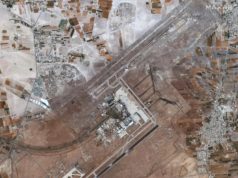A bomb blast rocked the Syrian capital of Damascus on Wednesday morning, killing President Bashar al-Asad’s brother-in-law Assef Shawkat, Defense Minister Daoud Rajha, and former Defense Minister Hassan Turkmani. Others, such as Syria’s Interior Minister Mohammad Ibrahim al-Shaar, were critically injured. The blast occurred during a meeting in a national security building with top regime officials, while fighting in the capital raged within sight of the presidential palace. The bomber was reportedly a bodyguard assigned to Asad’s inner circle. Col. Malek al-Kurdi of the Free Syrian Army, however, claims it was a remote controlled bomb that killed the officials. Both the Free Syrian Army and Liwa al-Islam have claimed credit for the bombing. These deaths represent one of the most serious losses for the regime.
In the midst of the battle for Damascus, termed Operation Damascus Volcano by the rebels, the Free Syrian Army called for an increase in attacks against security targets and for blocking roads across Syria. As the conflict continues to wear on, Syria’s army grows increasingly desperate. The Free Syrian Army claimed to have shot down a helicopter in Qaboun even as the regime escalated its attacks on civilians and rebels alike with artillery and helicopter rockets. The artillery fire combined with the use of helicopters on civilians only highlights how far the regime is willing to go to stay in power.

People gather at the site of an explosion in Aleppo, Syria. (Photo: Reuters) |
Following the attack, the regime vowed to punish those responsible for the explosions and subsequently launched a counterattack against rebel positions in Damascus. This new campaign will possibly include soldiers previously stationed near the Golan Heights. If the violence does not abate, this will be the third day of fighting inside the divided city. Residents went so far as to say that they are packing “getaway bags”.
Meanwhile, members of the regime and army are continuing to defect. General Manaf Tlass, a high ranking general and childhood friend of Bashar al-Asad, defected from the regime and called for an end to the violence. Though he has yet to publicly support the Free Syrian Army, he is rumored to be in contact with its leadership. Another high ranking figure of the regime, Syrian Ambassador to Iraq Nawaf Fares, also defected, stating that he believes this “is the beginning of the end.” He also said that Asad would use chemical weapons against opponents to remain in power.
With the fighting closing in on the presidential palace, the opposition’s ability to penetrate Asad’s inner-circle, and the loss of key military and intelligence pillars of the Asad regime, it would appear that Bashar’s days might be numbered. As Lebanese General Elias Hanna said, “Whoever can get to Asef Shawkat can get to Asad.” Today, perhaps more than any previous day of the uprising, Bashar al-Asad must be facing the difficult decision of whether to stay or go. If the past is any indicator, he may find himself sharing the same fate as Iraq’s Saddam Hussein or Libya’s Moammar Qaddafi.





